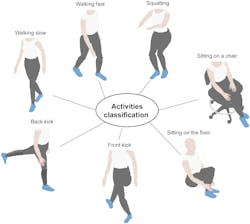The term “smarty-pants” is taking on a whole new meaning. Researchers from the Federal University of Espirito Santo (Brazil) have developed a completely noninvasive way to track a person’s physical activity—fiber-optic smart pants (see video).
The development is “part of a larger project related to the development of photonic textiles for low-cost wearable sensors,” says Arnaldo Leal-Junior, a professor with the University’s Department of Mechanical Engineering, who leads the work. The fabric is equipped with transparent 1-mm-diameter polymer optical fiber (POF) sensors based on the multiplexed intensity variation technique, which involves side coupling between the POF and light sources with controlled modulation. This sensor system is integrated into the pants, which look much like athletic tights.
“These sensors are based on optical power variation along the fiber,” Leal-Junior says.
There are two POF systems for the pants—one integrated into each leg—that contain 30 sensors (see Fig. 1). The team extracted the local optical variations along the optical fiber to obtain numerous measurement points on each leg of the pants. The fibers bend with movement, which prompts optical power changes through them; this allows the researchers to identify the types of movement.
By removing small sections of the fiber core’s outer cladding, they created the sensitive areas. Each sensor presented its sensitivities (108.03 ± 100 mV/mm), “which are used on the sensor normalization prior to the data analysis,” says Leal-Junior.
All in the details
Smartwatches and other similar wearable health tracking devices can detect and track movement. But the data acquired is generalized, without much detail offered about the exact activities and how they’re impacting the user.
In the team’s testing of the smart pants, volunteers performed several activities: walking (slowly and quickly), sitting in a chair and on the floor, squatting, and kicking (to the front and back).
“The acquired data is analyzed using neural networks we created, in which the gait parameters and activities performed by the user are obtained,” Leal-Junior says. The sensor system was 100% accurate at identifying each type of movement (see Fig. 2).
The electromagnetic immunity of optical fiber sensors “is an advantage,” Leal-Junior says. “In conjunction with their compactness and flexibility, these sensors can be integrated into different clothing accessories without harming the user’s natural movements.”
Fiber-optic smart pants could be used to remotely monitor patients. The team was motivated by the continuous aging of the general population, Leal-Junior says, which is placing demands on technological devices to provide continuous monitoring of patients.
“Our smart pants can be used in rehabilitation clinics for different protocols,” Leal-Junior adds, “as well as in the analysis of sports performance” and athletic training. “And our work can enable a new generation of wearable sensors.”
The next step is to integrate the smart pants into the cloud, while continuing testing with different patients at their homes.

Justine Murphy | Multimedia Director, Digital Infrastructure
Justine Murphy is the multimedia director for Endeavor Business Media's Digital Infrastructure Group. She is a multiple award-winning writer and editor with more 20 years of experience in newspaper publishing as well as public relations, marketing, and communications. For nearly 10 years, she has covered all facets of the optics and photonics industry as an editor, writer, web news anchor, and podcast host for an internationally reaching magazine publishing company. Her work has earned accolades from the New England Press Association as well as the SIIA/Jesse H. Neal Awards. She received a B.A. from the Massachusetts College of Liberal Arts.

